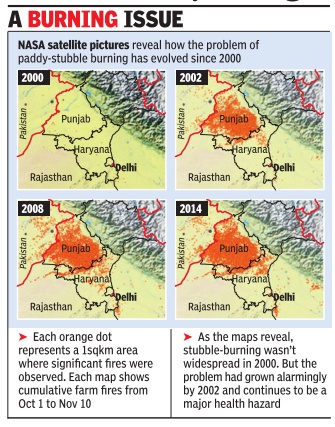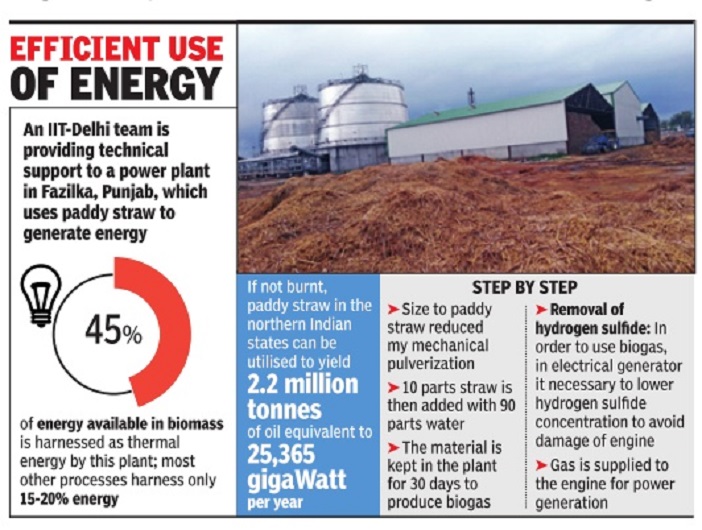Crop stubble burning: India
This is a collection of articles archived for the excellence of their content. |
Contents |
Burning rice stubble
Amit Bhattacharya The Times of India, Nov 03 2015

Widespread crop burning began over dozen yrs ago
Satellite images reveal age-old norm
The practice of burning paddy stubbles in Punjab and Haryana has of late been recognised as a major contributor to air pollution in the national capital region during October-November. Satellite images, however, reveal that the problem had already reached alarming proportions as early as 13 years ago. Farm fires in the region began to register in satellite images in year 2000. Not that stubble burning did not take place before that, but the practice probably became widespread enough in 2000 for it to show up in the 1-square-km resolution satellite images. By 2002, the `fires spots' in the satellite pictures had filled up almost the entire state of Punjab and parts of northern Haryana.
TOI obtained the data from Nasa's FIRMS Fire Mapper website, which enables users to access satellite imagery from the past.
To get a season-wide picture perspective, cumulative fire data was considered from October 1 to November 10 -a 40-day period when farmers in the region burn their paddy stubble to prepare the fields for the next crop.
What the information reveals is that successive governments in the states have failed to check the practice despite a law that bans stubbleburning. The problem assumes more serious proportions with each passing year due to the fact that pollution from other sources are on the rise in NCR. So, the added pollutants that come from biomass burning make the situation graver.
The concentration of farm fires in Punjab and northern Haryana shows the extremely high proportion of farmers opting to grow paddy during the kharif season. As Ruby Singh Sandhu, a big farmer from Mallekan village in northern Haryana puts it, “Farmers in the cotton growing areas of Punjab and Haryana have been slowly shifting to paddy for more than a decade now.“
Did mechanical harvesting start the epidemic?
Chandigarh:
The advent of combine harvesters in Punjab, Haryana and UP, in the late 1980s and early 1990s, is being blamed for the practice of burning crop stubble. To save time and money, as well as to tackle labour shortage, more and more farmers are opting for mechanical harvesting of crops using combine harvesters.
Farmers say the blades of combine harvesters don't cut the crops close to the ground, and leaves the plant stalk, usually up to two feet high, standing.
Sarabjit Singh, a farmer from Virpur village of Bijnor district in UP , said the people who operate combine harvesters don't cut the crop close to the ground since they are more concerned about getting the grain. “The operators try to clear the maximum possible area in a day since they charge per acre. Hence, they leave the task of clearing the crop to the farmers. The crop stalk is very high at times,“ he added.
Farmers find it difficult to plough the crop residue back into the soil using harrows and, instead, resort to burning the stubble to clear the fields for the next crop. The problem is more pronounced in the winter, with little time available for farmers to prepare the fields for sowing wheat after harvesting paddy.
The prevailing rates for harvesting paddy using combine harvesters in north India are in the range of Rs 1,300-1,500 per acre. On the other hand, labour charges of harvesting paddy manually are around Rs 1,600 per acre, a practice more prevalent in UP, MP and parts of Haryana.
Another farmer, Baljinder Singh Sidhu from Kotbhara vil lage in Punjab's Bathinda district, said the days of manual harvesting were better: “Earlier, when paddy was manually harvested, the crop was cut close to the ground. While the grain was obtained after threshing, the leftover plant stalk or straw was stored as fodder for cattle.“
Sadhu Singh, director of Akhtiar Agro King, an agriculture machinery manufacturing unit in Moga, said the problem was acute in Punjab since the farmers don't consider paddy straw to be of any use.
“In case of wheat, the combine harvesters usually cut the crop close to the surface. However, farmers in Punjab don't keep paddy straw, so they don't insist on a close cut for the crop,“ he added.
Health issues
Study links straw burning to cancer, kidney damage
Crop residue fires in Pun jab and Haryana are en hancing concentrations of toxic gases like benzene and toluene, according to research from Indian Institute of Science Education and Research (IISER), Mohali.
In the months right after the harvest of paddy , the levels of these gases were found to be 1.5 times higher than the annual average concentrations, according to a recent study that monitored air at a site in Mohali a few kilometres downwind of paddy fields, between 2012 and 14. Farmers set fire to crop residue after harvest, which sends massive plumes of smoke into the air.
The study also detected, for the first time, a compound known as isocyanic acid at annual average levels close to the toxic threshold of 1ppb (parts per billion). Exposures above this level can lead to cataracts and rheumatoid arthritis.
Annual concentrations of benzene, a known carcinogen, exceeded the National Ambient Air Quality Standard of India limits of 1.6ppb. Such benzene exposure could raise cancer risk by 25 per million children and 10 per million adults, the study estimated, at sites 10-15 km downwind of the fields.
The cancer risk would be even higher for farmers and villagers closest to the fields, the study said, adding that mitigating crop fires could reduce these risks.
The findings come from the first long-term field measurement in India of the impact of post-harvest agricultural fires on ambient levels of gases known as volatile organic compounds. The gases measured in the study include acetonitrile, benzene, toluene, and aromatic hydrocarbons. These substances have direct effects on human health -high levels of toluene can cause dizziness, eye irritation, kidney damage, for instance -but can also react with other substances to form secondary pollutants.
Unlike particulate matter, which gets filtered to some extent by the nose and throat, gases like benzene go straight into the lungs, said Vinayak Sinha, an associate professor at IISER's Department of Earth and Environmental Sciences who led the research team. The emission of isocyanic acid was of particular concern, he said. “This substance is related to methyisocyanate, which was emitted in the Bhopal accident, and is very dangerous,“ Sinha said.
Isocyanic acid is known to be produced by biomass burning, diesel exhaust and other sources. But its measurement as an environmental pollutant has only recently begun.
Sinha and others first identified the emission of benzene and related gases from harvest fires in 2013 by studying the effects of a single plume on a single night in 2012. The latest study , published recently in the journal `Environment International', quantifies the contribution of crop residue burning to the levels of these gases over multiple years.
IIT/ D: Make biogas instead of burning stubble
Manash Gohain, IIT-D shows how Punjab can re-use farm waste, Nov 13 2016 : The Times of India
Instead Of Burning, Paddy Straw Can Be Used To Make Biogas
Are you a farmer? How about earning a handsome amount from the stubble left behind in your field instead of burning it and adding to the pollution level?
How about also getting biofertiliser and sustainable energy in the same deal?
An IIT-Delhi team has provided technical support to Asia's first biogas-based power plant which is now operating on paddy straw for largescale biogas production in Fazilka, Punjab. The system is based on 100% use of paddy straw and has been generating nearly 4,000 cubic metres per day of biogas from 10 tonnes of straw. This is in turn generating 1MW power.
This sounds like welcome way out of the pollution mess that the capital has found itself in. Going by reports, 70% of Delhi's air pollution is due to stubble burning in Punjab, Haryana and other parts of north India.
Professor V K Vijay of Centre for Rural Development and Technology (CRDT) of IIT-D said paddy straw, if not burnt, could yield 2.181 million tonnes of oil equivalent or 25,365 gigaWatt hours per year.“Straw burning can be avoided through installation of commercial biogas industries by using these agro biomass for both power generation and biofertiliser production to enrich soil health. The present level of utilisation at Fazilka has shown a saving of 120 gigaJou les per day energy which otherwise would have been released to the atmosphere by direct combustion along with the release of enormous pollutants,“ said Vijay.
He added, “Burning straw biomass amounts to 30kg of particulate matter, 600kg of carbon monoxide, 14.6 tonnes of carbon dioxide and 20kg of sulphur dioxide emissions, which have significant toxicological properties and are potential carcinogens.“
Abhinav Trivedi, a doctoral fellow working under the guidance of Vijay , developed this process that has better efficiency than conventional processes for biogas generation.
Dr Ramchandra of CRDT said the project was started in December 2011 by the Punjab government in association with Sampurn Agri Ventures Pvt Ltd. “After our intervention for around six months, the plant is running for nearly eight hours per day for the same amount of straw against two hours earlier. It is generating 7,500 kiloWatt hour per day and nearly five tonnes of bio-fertilisers per day ,“ he said. Ramchandra also said that the system was able to harness over 45% of energy available in the material.
